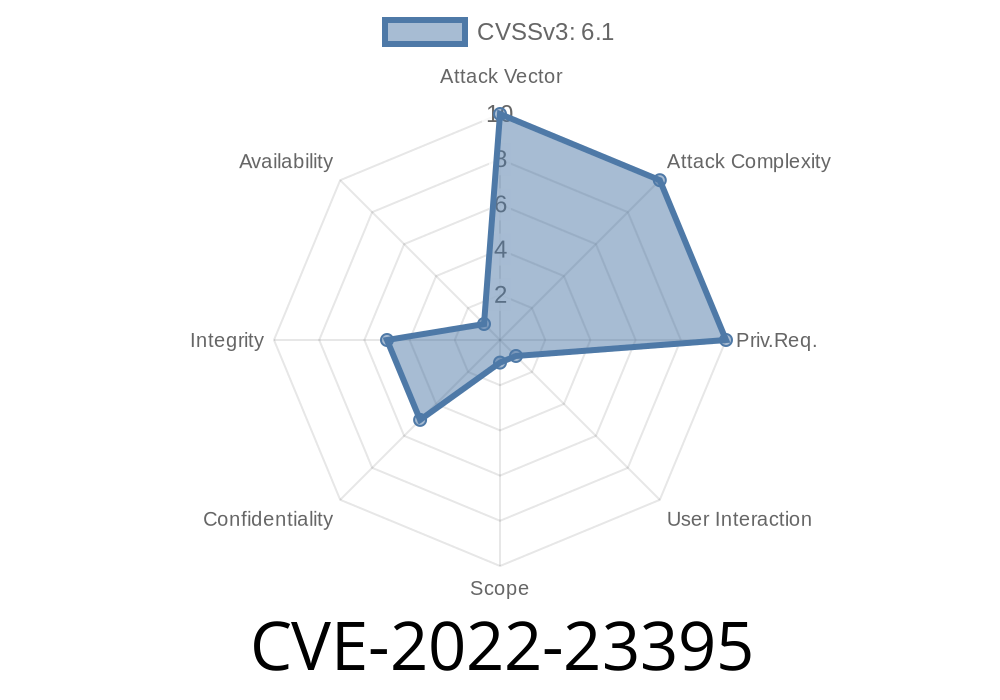The well-known jQuery Cookie plugin, version 1.4.1, has been identified as susceptible to prototype pollution, a vulnerability that presents a grave security risk. This vulnerability can potentially give way to DOM cross-site scripting (XSS) attacks, exposing sensitive user data, and causing potential harm to both the targeted application and its users.
Prototype pollution refers to a design flaw that permits an attacker to modify a JavaScript object's prototype, which can have severe consequences for widely used JavaScript applications and their users.
In light of this issue, this post aims to provide a comprehensive analysis of the vulnerability CVE-2022-23395, walk you through its exploitation, as well as provide you with solutions to mitigate the risk. We will be leveraging code snippets and external references to enhance understanding and provide useful context.
Exploit Details
The jQuery Cookie plugin is a lightweight, convenient tool for managing cookies with a simple syntax. However, version 1.4.1 suffers from a design flaw, potentially leaving the plugin susceptible to prototype pollution.
The vulnerability arises because the plugin fails to validate and sanitize user input before utilizing it for manipulating the JavaScript object prototype. As a result, bad actors can modify the properties of the Object.prototype to inject malicious code into an unsuspecting user's DOM.
The following code snippet demonstrates the exploit
// Using a malicious payload in a URL parameter
example.com?search=%3Cimg%20src%3Da%20onerror%3Dalert(%22XSS%22)%3E
// The application uses the jQuery Cookie plugin
$.cookie("user_preference", "search=%3Cimg%20src%3Da%20onerror%3Dalert(%22XSS%22)%3E");
// When an object is merged/appended with the polluted prototype
const added_preference = $.extend({}, preferences);
As seen in the sample code above, a simple unsanitized URL parameter containing an XSS payload could easily lead to a DOM XSS vulnerability.
Original Reference and Detailed Explanation
For a more in-depth understanding of CVE-2022-23395, you can delve into the original security advisory released by the maintainers of jQuery Cookie, which also provides background information on the vulnerability and its implications. This advisory is available at the following link: jQuery Cookie Security Advisory
Possible Solutions and Mitigation Steps
To protect your application from CVE-2022-23395 and the risks associated with prototype pollution, you should consider the following steps:
1. Update: Upgrade your jQuery Cookie plugin to the latest version, which addresses this vulnerability. You can do so by visiting the GitHub repository for the jQuery Cookie plugin: jQuery Cookie Repository
2. Input Sanitization: Always validate and sanitize any user-supplied input that could be utilized in manipulating JavaScript objects. This process ensures that all data is reasonably secure and devoid of harmful code before being fed into your application.
3. Content Security Policy (CSP): Implement a robust Content Security Policy, which instructs browsers to only execute trusted script sources. This precaution effectively reduces the risk of DOM XSS attacks.
4. Keep Dependencies Updated: Regularly review and update your dependencies to minimize the risk that vulnerabilities pose to your application.
Conclusion
CVE-2022-23395, which impacts jQuery Cookie 1.4.1, is a serious vulnerability that may expose your application to prototype pollution and subsequent DOM XSS attacks. By keeping abreast of the latest security updates, utilizing input validation and sanitization techniques, and following best security practices like implementing a strong Content Security Policy, you can effectively safeguard your application and its users.
Timeline
Published on: 03/02/2022 12:15:00 UTC
Last modified on: 04/18/2022 18:36:00 UTC
